Short Put Butterfly
This strategy profits if the underlying stock is outside the wings of the butterfly at expiration.
Description
Buying two puts at a middle strike, and selling one put each at a lower and upper strike results in a short put butterfly. The upper and lower strikes (wings) must both be equidistant from the middle strike (body), and all the options must be the same expiration.
Outlook
The investor is hoping for the underlying stock to be outside of the wings at expiration of options.
Summary
This strategy profits if the underlying stock is outside the wings of the butterfly at expiration.

EXAMPLE
- Short 1 XYZ 65 put
- Long 2 XYZ 60 puts
- Short 1 XYZ 55 put
MAXIMUM GAIN
- Net premium received
MAXIMUM LOSS
- High strike - middle strike - net premium received
Motivation
To capture a move in the underlying or an increase in implied volatility during the life of the options.
Variations
The short call butterfly and short put butterfly, assuming the same strikes and expiration, will have the same payoff at expiration.
They may, however, vary in their likelihood of early exercise should the options go into the money or the stock pay a dividend. While they have similar risk/reward profiles, this strategy differs from the long iron butterfly in that a positive cash flow occurs up front, and any negative cash flow is uncertain and would occur somewhere in the future.
Max Loss
The maximum loss would occur should the underlying stock be at the middle strike at expiration. In that case the short put with the upper strike would be in-the-money and all the other options would expire worthless. The loss would be the difference between the upper and middle strike (the wing and the body), less the premium received for initiating the position, if any.
Max Gain
The maximum gain would occur should the underlying stock be outside the wings at expiration. If the stock were above the upper strike all the options would expire worthless; if below the lower strike all the options would be exercised and offset each other for zero profit. In either case the investor would pocket the premium received for initiating the position.
Profit/Loss
The potential profit and loss are both very limited. In essence, a butterfly at expiration has a minimum value of zero and a maximum value equal to the distance between either wing and the body. An investor who sells a butterfly receives a premium somewhere between the minimum and maximum value, and profits if the butterfly's value moves toward the minimum as expiration approaches.
Breakeven
The strategy breaks even if at expiration the underlying stock is above the lower strike or below the upper strike by the amount of premium received to initiate the position.
Volatility
An increase in implied volatility, all other things equal, will usually have a slightly positive impact on this strategy.
Time Decay
The passage of time, all other things equal, will usually have a negative impact on this strategy if the body of the butterfly is at-the-money, and a positive impact if the body is away from the money.
Assignment Risk
The short puts that form the wings of the butterfly are subject to exercise at any time, while the investor decides if and when to exercise the body. The components of this position form an integral unit, and any early exercise could be extremely disruptive to the strategy. Since the cost of carry sometimes makes it optimal to exercise a put option early, investors using this strategy should be extremely wary if the butterfly moves into-the-money.
And be aware, a situation where a stock is involved in a restructuring or capitalization event, such as a merger, takeover, spin-off or special dividend, could completely upset typical expectations regarding early exercise of options on the stock.
Expiration Risk
This strategy has expiration risk. If at expiration the stock is trading right at either wing, the investor faces uncertainty as to whether or not they will be assigned on that wing. If the stock is near the lower wing, the investor will be exercising their puts from the body and is nealry certain of being assigned on the upper wing, so the risk is that they are not assigned on the lower wing. If the stock is near the upper wing the investor risks being assigned at the upper wing. The real problem with the assignment uncertainty is the risk that the investor's position when the market re-opens after expiration weekend is other than expected, thus subjecting the investor to events over the weekend.
Comments
N/A
Related Position
Comparable Position: Short Call Butterfly
Opposite Position: Long Put Butterfly

